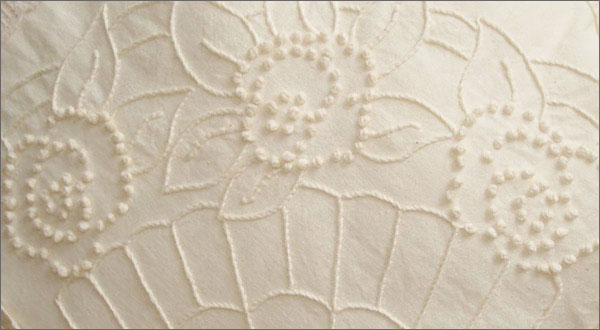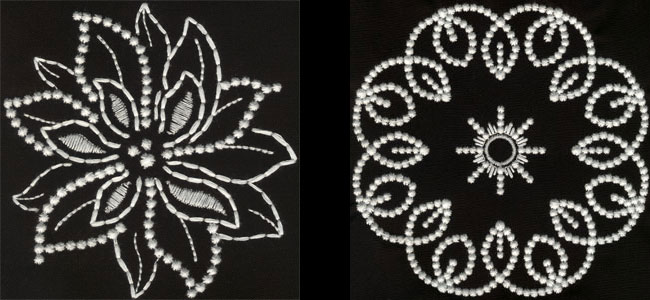History of Candlewicking
Candlewicking began in America by the women who traveled out to the wild and untamed West. Learn more about its history and a how-to tutorial.
Candlewicking began in America by the women who traveled out to the wild and untamed West.
The women wanted comfort in the harsh and lonely places that they would settle in and call home. They wanted, as their ancestors had, to create beautiful and decorative pieces for their homes. For many, needlecrafts were also therapy to ease the fears of the harsh wilderness.
The settlers did not have the luxury of bringing many of their possessions with them, just the bare necessities. And certainly, there were no stores for miles and miles. They had to make do with the items they had on hand, so these women became very resourceful.
What could they use to stitch with? They didn’t have fabrics, threads, and notions available. It was customary to repurpose a worn-out dress or shirt for fabric, but thread was different. Some fabrics allowed you to take the fabric apart and create threads, but the thread would not last long, and embroidery required a lot of it.
Candles and supplies were more plentiful and very important on the prairie lands. The common dipped candles used a cotton fiber called a wick. These resourceful women found that this wick could be used for embroidery, which led to the name Candlewick Embroidery. Even though the cotton wick was generally available, it was best to be conservative with it. Because of this, open-look designs outlined in knots were used rather than satin stitches or other common embroidery stitches, as this method took less thread. To conserve thread, the Colonial Knot was created, as it required less thread than the French Knot. The Colonial Knot is also called the Figure 8 Knot. It is made by looping the thread around the needle, creating an actual knot.
Most of the designs were simple and stitched on unbleached muslin fabric. After the embroidery was completed, the fabric would be washed in very hot water to shrink the fabric and cause the stitches to fluff up, which would hold the stitches in place and give the puckered look of what would become traditional candlewicking.

To create traditional candlewicking by hand, use 100% cotton unbleached muslin fabric. Do not prewash your fabric if you want the traditional look. Next, transfer the design onto the fabric with a marking pen or iron, depending on the design. Use an embroidery needle with a sharp point and a long eye. For the thread, look for 100% cotton that is labeled for candlewicking. The thread has four strands that can be separated. Hoop your fabric and keep it taut for easier stitching. The size of your hoop will be determined by the size of your design.
Common candlewicking stitches are the French and Colonial Knots, stem/outline, satin, and padded satin stitches. They usually are stitched with two strands of candlewicking thread. To keep the embroidery hoop from crushing the French and Colonial Knots, it is best to stitch them last.
For the embroidery machine, designs are drawn and digitized using candlewicking embroidery stitches, such as French Knots, satin stitches, and linework, using one color of thread. If you want an
authentic look to your designs, use a 30 weight cotton embroidery thread, instead of the 40 weight embroidery thread.
Let’s take a look at one of OESD’s candlewicking embroidery collections:
The last embroidery collection is Whitework Holiday #12428. It includes 35 whitework classic Christmas patterns, including candlewicking. This collection is actually created to work with 30 weight cotton embroidery thread. The results are an authentic looking candlewicking embroidery.

The Whitework Throw Pillow featured with the Whitework Holiday embroidery collection is a combination of several of the designs stitched on red fabric with white cotton thread. The complete instructions for the pillow are included in the embroidery collection. Be sure to test your fabric and thread for bleeding of fabric color.

Candlewicking embroidery boasts the resourcefulness of women on the prairies when our country was in its infancy. Let us not take the availability of the things that we have for granted! How resourceful are you? Would you have been able to live on the prairies and the wild untamed west? Would you have been as resourceful as your four-times-great-grandmother, or would you have complained? I think these are good questions to ask ourselves. Enjoy stitching knots of all kinds!
This material is © OESD, LLC and may not be reproduced or published without permission.
